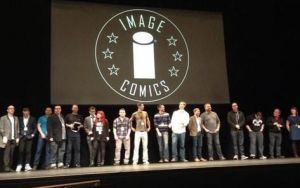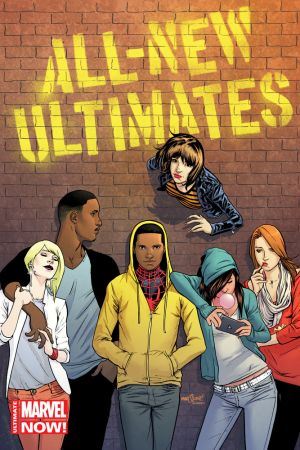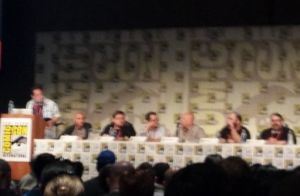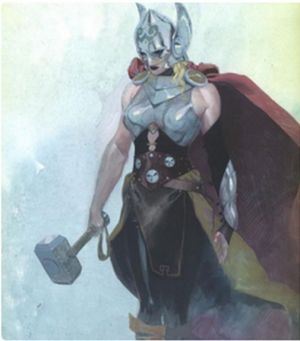Comics/Culture #1: Marvel's Failed Diversity
By Zak Edwards
August 15, 2014 - 12:56
Welcome to Comics/Culture, a new weekly column here at the Comic Book Bin by yours truly, Zak Edwards! I'll be looking at comics and their cultural significance and interpretations every week. Come by every Friday to check it out and keep glued to my Twitter feed for more thoughts on comics and culture.
This is an extension of a piece that I ran at Nexopia.
The January Image expo featured over 20 announcements for new series from some of the industry's top talent, but none of those series turned out to be the event's most iconic moment. That happened when all the creators gathered onstage, and people noticed only a single demographic was represented by the 30 smiling faces: they were all white males. This became the focus, much to Image's dismay, and rightfully so.
 |
| Image Expo in January. |
Fast forward to the July Image Expo right before the San Diego Comic Con. Eleven new series were announced, but unlike January, Image thought about their creator diversity. So when the creators all gathered up on the stage, women and persons of colour were there arm in arm. This second lineup proved two things: that Image is home to some of the most innovative and interesting work in mainstream comics, and that the publisher is taking active steps to foster new and unique voices behind these projects. Image, it seems, wants to take steps that ensure the people behind comics are just as diverse as their stories, characters, and readers.
 |
| The All-New Ultimates |
"Captain America is going to be black!" "Thor's a lady!" "A-Force is all women!"
All this on top of a biracial Spider-Man and the many merry bands of diverse-looking characters. According to themselves, Marvel is making the inclusion of minorities a top priority. It's something that will hopefully set them apart form their rival DC Comics, who continually puts out fires concerning their editorial practices, like comment made by DC editor Ian Sattler who, when asked about DC’s racial diversity, responded with, “I mean, we have green, pink, and blue characters.” Coupled with barring lesbian Batwoman from getting married and David Finch’s latest ignorance on the word "feminist," DC isn’t winning many friends. But Marvel? Well they’re gender-swapping Thor, look at that! Marvel's inclusive!
And fair enough, Marvel is gunning to be more diverse, taking risks to appeal to a larger audience over pandering to an old guard of entitled white men. One of their head editors, Tom Brevoort, went on The View (The View!) to discuss the changes to Marvel’s flagship characters. “We have more readers of different backgrounds,” he said, “[Readers] who are hungry for characters who come from circumstances like their own.” He also sarcastically apologized to detractors of the changes. “For all the folks that wrote in about this," Brevoort said with a smile, "I’m sorry there are no longer any white heroes in comics you can relate to.”
Plenty of people are rightly celebrating this diversification of characters. In the Toronto Star, Raju Mudhar praised the move, mentioning that he’s keeping copies of Ms. Marvel aside for his daughter when she’s older. Others lament the changing of existing characters, wishing instead that new characters were created who can occupy these needs for diversity. That argument, however, sounds close to the argument against gay marriage that simply says “Can’t they call it something else?” It’s a way of excluding through including, saying “You can have everything but what you actually want.”
But, despite all their grandstanding, if Marvel took all the writers and artists to the stage, their attempts at diversity would look more like Image Expo in January than Image Expo in July. The creators don’t reflect this diversity, not even remotely. In fact, Marvel’s entire credited labour force is shockingly dominated by straight, white men. And while there is nothing wrong with people writing characters outside their own gender, race, or culture (Terry Moore and Kieron Gillen have proven that, just to name a couple), the question remains as to why Marvel thinks it’s okay to parade around this diversity while employing an almost singular workforce.
 |
| A somewhat fuzzy photo from this year's Cup O' Joe panel, but there sure are a lot of white guys. |
Take for example that Marvel hasn’t credited a female letterer in nearly three years. Simply not one letterer is female. Only 3% of comics they put out in May 2014 were drawn by women, only 2% inked by women. Women writers consist of 6% of Marvel's writing staff. The only credited position at Marvel Comics which has any decent number of women is assistant editors, where the numbers hover around the half. Full editors is at 19%. The comics industry in general has such poor representation of gender that Bleeding Cool has a monthly article, Gendercrunching, dedicated to tracking their terrible business practices. And while Marvel will be quick to point out that Ms. Marvel is a book about a Muslim girl written by a Muslim woman, the stats surrounding G. Willow Wilson’s contribution almost makes her seem like the token, regardless of the stellar work she's doing for the publisher.
 |
In their statements as to why they’re making their characters more diverse, Marvel has stuck to two answers: To reflect their diverse audience and to find new readers of different backgrounds. As for their shockingly outdated diversity in employment, they aren’t taking those questions, don’t respond to them, or point to their few female creators, extensive female support staff, and the occasional hiring of PoCs for special projects. For the day-to-day, we are left with A-list characters still controlled almost exclusively by the old guard Tom Brevoort mocked on The View.
But the question is not why Marvel seems intent on keeping their workforce extremely limited in diversity. Instead, the question is why Marvel doesn’t see the value in having people from different genders, races, and cultures participate in their obvious attempts to diversify their fanbase through its characters. Surely the people coming to these books would appreciate the story of a person from their background making it in the comic business almost as much as they love the characters themselves.
That's the issue. It seems Marvel is doing what it always does: sees where the money is an uses its characters to get it. They aren’t rocking any boats, they're creating false scandal to sell books. The value isn’t the diverse readership or finding the value in other people, it’s finding the money in other people. And while a black Captain America and lady version of Thor may find and inspire new readers, those readers are still left out if they ask Marvel themselves to see the value in their voices. Marvel’s business practices show a company that values Othered money, not Othered labour value.
Related Articles:
Hermeneutics, Cancel Culture, and Comics
Comics/Culture #5: Superheroes vs. #HeForShe
Comics/Culture #4: Watchmen's Squid
Comics/Culture #3: Stray Bullets and Billy Joel
Comics/Culture #2: The Economics of Spoiler Alerts
Comics/Culture #1: Marvel's Failed Diversity
The New Age of Comics & Culture (Part 3 of 4!)
The New Age of Comics & Culture (Part 2 of 4!)
The New Age of Comics & Culture (Part 1 of 4!)
SDCC 2010: MBP Presents Black Comix: African American independent comics, art and culture
